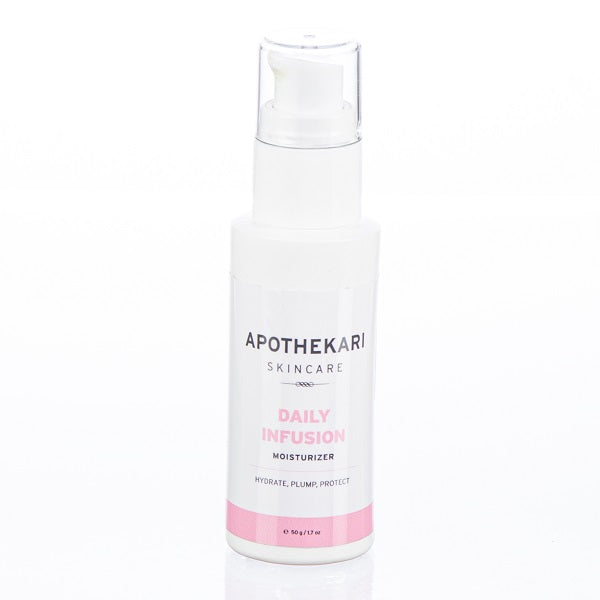Blog
A Light Face Moisturizer for Warmer Weather
If you’re looking for a face moisturizer for warmer weather, Apothekari Daily Infusion Moisturizer may be just what you’re looking for. In this post we’re discussing tips to help you find one that’s just right for your skin. Want information about moisturizers in general? Check out this post we wrote earlier. Shop Daily Infusion Moisturizer A face moisturizer is a product that we apply to skin to relieve dryness and make it feel more comfortable. They can range from lighter serums and lotions to heavier and thicker treatments such as petroleum jelly (although this isn’t something we’d recommend!). Water qualifies as a moisturizer, but because it evaporates quite quickly, it’s not very effective on its own. The ideal face moisturizer falls somewhere in between water and petroleum jelly and many customers find that a product like Apothekari Daily Infusion Moisturizer works perfectly for them all year round because it moisturizes without leaving skin feeling greasy. It’s also suitable for all skin types. Moisturizer Ingredients Moisturizers are made up of three main types of ingredients: Humectants. Deliver moisture to skin by either grabbing it from the environment or pulling it from the skin’s deeper layers (dermis) to its surface layers (epidermis). Hyaluronic acid (sodium hyaluronate), glycerin, propanediol, honey and propylene glycol are all examples. Emollients. Soften and smooth skin by filling in the gaps. May also lock in moisture. Fats and oils like vitamin E, cholesterol, jojoba oil and some silicones are emollients. Emollients may also have occlusive action. Occlusives. Work by forming a thin, oily layer over skin, helping to lock in moisture. They should be applied over damp skin, ideally. Lanolin, beeswax, petroleum jelly and fatty alcohols like cetyl alcohol and stearyl alcohol are occlusive. Some occlusives may also have emollient activity. The combination and amounts of each ingredient influence how light or heavy a moisturizer feels. A Face Moisturizer for Warmer Weather Humidity (the amount of moisture in the air) changes depending on where you live or the season. Tropical locations and summer often bring higher humidity while winter and desert or cooler climates tend to be drier. A heavy moisturizer (one with more emollient and occlusive ingredients) that was perfect for cooler winter temperatures may feel too heavy now. If you find that your skin is left feeling greasy or oily now that it’s warmer outside, it may be time to revisit the moisturizer you’re using. Opt for one that contains fewer occlusive ingredients and that contains more humectant ingredients. Our Daily Infusion Moisturizer has a good balance of humectants (glycerin), light emollients (caprylic/capric triglyceride, coco-caprylate/caprate, squalane) and occlusives (cetearyl alcohol, cetearyl glucoside, glyceryl stearate) to deliver light moisture that all skin loves. We refer to it as the ‘Goldilocks of Moisturizers’ because most of our customers feel it’s just right! Tips: In order to maximize the effectiveness of your moisturizer, keep the following in mind: Apply over damp skin to lock in moisture. Moisturize as often as you need to. Don’t forget sunscreen to help protect skin against damage from UV rays. Now you and your face are ready for summer!
Learn moreHyaluronic Acid Love
When it comes to effective skin care ingredients, hyaluronic acid skin care products (along with related sodium hyaluronate) rank right up there with other superstars including l-ascorbic acid, retinoids and sunscreen. This naturally occurring substance is a carbohydrate that is found in our joints, our eyes and connective tissue, along with our skin. It helps to lubricate things and also has an immense capacity to attract and hold large quantities of moisture. It can do this without the skin receiving too much water, which can be just as bad for skin as too little. Aging skin loses its ability to maintain moisture, resulting in the visible loss of firmness, pliability, and plumpness. Hyaluronic acid acts as a humectant (attracts moisture from the environment into the skin) and replenishes moisture that is essential to the appearance of younger-looking, healthy and supple skin. Other ingredients, including glycerin and propanediol also do this, but hyaluronic acid is far more effective, capable of holding 1000 times its weight in water! The result is skin that looks and feels softer, smoother and hydrated, with a diminished appearance of fine lines and wrinkles. What about sodium hyaluronate? This salt form of hyaluronic acid also acts as a humectant but is more stable and less likely to oxidize. It also has a lower molecular size, helping it to penetrate deeper into the skin. Chemists, however, have developed low molecular weight versions, which solves this issue. The key is not to go too low with the molecular weight as this can lead to skin inflammation. Hyaluronic Acid Skin Benefits – More… You don’t need super high concentrations of either sodium hyaluronate or hyaluronic acid. Concentrations of 2% and less deliver great results so don’t be surprised to see them listed at the end of the ingredient list. Higher concentrations can conversely, dry the skin. While hydration is the main reason to incorporate hyaluronic acid, it also can: Increase skin elasticity Fight inflammation, thereby helping to soothe skin irritations such as atopic dermatitis and rosacea as well Deliver antioxidant benefits, helping to protect skin against free radical damage. Useful for all skin types, we love hyaluronic acid for its multi-tasking ability. Oily or combination skin types benefit from non-greasy hydration. Because it is so gentle, even sensitive and redness prone skin is able to tolerate it. Find it as sodium hyaluronate in our Bespoke Vitamin C 15% Serum (10% too).
Learn more


